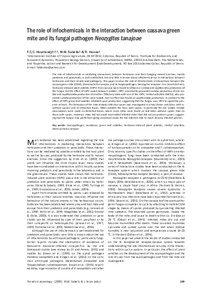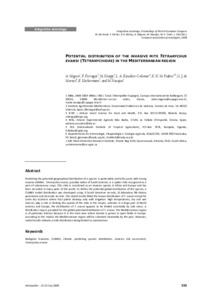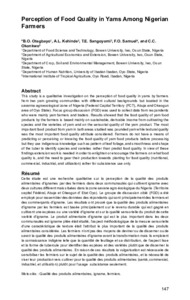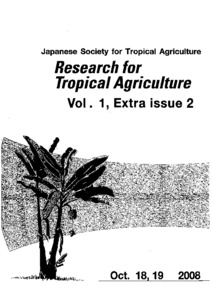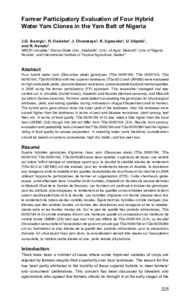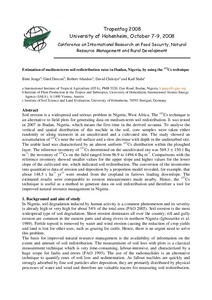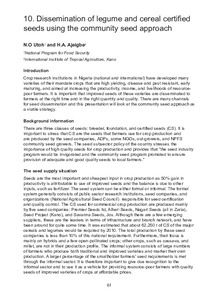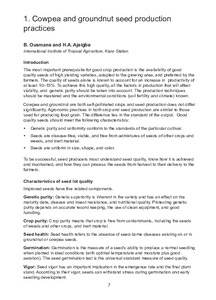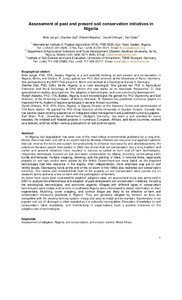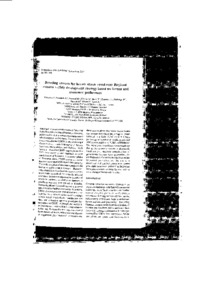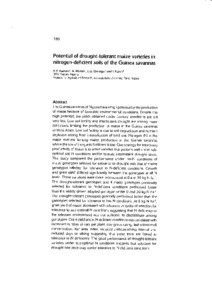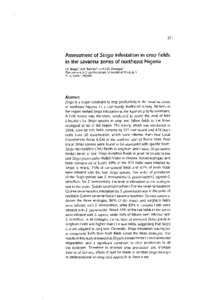Welcome to the International Institute of Tropical Agriculture Research Repository
Conference Documents: Recent submissions
Now showing items 621-640 of 726
-
Screening and breeding for resistance to maize stem borers and Eldana in West and Central Africa
(2009)Stem borers are one of the major constraints limiting maize productivity in Africa. The most important species reducing maize yield in West and Central Africa are Sesamia calamistis, Eldana saccharina and Busseola fusca. Both the pink stem borer (Sesamia calamistis Walker (Pyralidae) and the sugarcane borer Eldana saccharina Hampson (Noctuidae) infest and reduce maize yields in the lowlands of West and Central Africa. Host pant resistance is very effective in managing the pests and researches ... -
Role of infochemicals in the interaction between cassava green mites and its fungal pathogen Neozygites tanajoae
(2009)The role of infochemicals in mediating interactions between herbivores and their foraging natural enemies, mainly predators and parasitoids, is well established, but very little is known about infochemical use in interactions between herbivores and their sit-and-wait pathogens. This paper reviews the role of infochemicals in interactions between the cassava green mite (CGM), Mononychellus tanajoa,and its fungal pathogen, Neozygites tanajoae. In a closed-dish test, herbivore-induced plant volatiles ... -
Potential distribution of the invasive mite Tetranychus evansi (Tetranychidae) in the Mediterraean region
(2008)Predicting the potential geographical distribution of a species is particularly useful for pests with strong invasive abilities. Tetranychus evansi, possibly native of South America, is a spider mite recognized as a pest of solanaceous crops. This mite is considered as an invasive species in Africa and Europe and has been recorded in many parts of the world. To define the potential global distribution of the species, a CLIMEX model distribution was developed using: i) South American records, ii) ... -
Perception of food quality in yams among Nigerian farmers
(2009)This study is a qualitative investigation on the perception of food quality in yams by farmers from two yam growing communities with different cultural backgrounds but located in the savanna agroecological zone of Nigeria (Federal Capital Territory (FCT), Abuja and Okeogun area of Oyo State). Focus group discussion (FGD) was used to collect data from respondents who were mainly yam farmers and traders. Results showed that the food quality of yam food products by the farmers is based ... -
Optimum time for collecting root samples for chromosome observation in Dioscorea spp.
(2010)The genus Dioscorea is considered to be one of the most difficult groups for cyto-taxonomic studies because of the large number and small size of the chromosomes. The objective of the present study was to develop an efficient method of chromosome. Observation by identifying the optimum time for collecting root samples containing large number so for metaphase cells. In the present investigation, two breeders’ lines developed at IITA, TDa98/01183(D. alata) and TDr95/18544(D. rotundata) which were ... -
Grain yields of rust resistant promiscuous soybean lines in the Guinea savanna of Nigeria
(2009)Soybean rust, caused by Phakopsora pachyrhizi, has become a threat to soybean production in west, central, east and southern Africa. This foliar disease can cause 40-80% yield loss under African conditions. IITA started to develop resistant lines for this disease since 2003 and a number of homozygous lines from the breeding program have reached line evaluation stage. Seventeen F8 rust resistant lines derived from the cross TGx 1805-31F (rust susceptible elite line) with UG 5 (rust resistant line), ... -
Farmer participatory evaluation of four hybrid water yam clones in the yam belt of Nigeria
(2009)Four hybrid water yam (Dioscorea alata) genotypes (TDa 00/00194, TDa 00/00103, TDa 00/00104, TDa 00/00363) with two superior landraces (TDa 92-2 and UM 680) were evaluated for high and stable yields, pest and disease resistance, and acceptable food and market qualities in 2006 using the farmer participatory (FP) approach. This researcher managed trial was carried out in Umudike (humid forest), Abakaliki and Nsukka (derived savanna), and Makurdi (southern Guinea savanna). ... -
Estimation of medium-term soil redistribution rates in Ibadan, Nigeria, by using the 137 Cs technique
(2008)Soil erosion is a widespread and serious problem in Nigeria, West Africa. The 137 Cs technique is an alternative to field plots for generating data on medium-term soil redistri bution. It was tested in 2007 in Ibadan, Nigeria, which means the firs t time in the derived savanna. To analyse the vertical and spatial distribution of this nuclide in the soil, core samples were taken either randomly or along transects in an uncultivated and a cultivated ... -
Assessment of past and present soil conservation initiatives in Nigeria
(2008)In Nigeria, soil degradation has been one of t he most critical environmental problems for a long time. Hence, there has been and still is an urgent need t o develop effective soil resource management system s that can reverse the trend and sustain soil product ivity to enhance food security and alleviate povert y. An extensive literature search that started in 2006 ha s shown that soil conservation has a long tradition and earlier and present initiatives have resulted in va rious ... -
Sweetpotato crop improvement in sub-Saharan Africa and future challenges
(International Society of Tropical Root Crops, 2007)In sub-Saharan Africa region, most sweetpotato are produced from diverse landraces that have constant turnover. The preference for high dry matter is between 28 to 35%. CIP breeding strategy for the past 15 years has been to collect, characterize, and conserve farmers' varieties; evaluate and distribute the best performers regionally. It has also emphasised population development through crosses and systematic screening with partners using participatory methods. Key stages of breeding programme ... -
Breeding cassava for brown streak resistance: regional cassava variety development strategy based on farmers and consumer preferences
(International Society of Tropical Root Crops, 2007)Cassava is an important food crop in the East African coastal lowlands. However, yields are low due to various reasons amongst which are pests and diseases. Cassava brown streak virus disease (CBSD) is one of the major diseases of economic importance in Kenya, Tanzania, Mozambique and Malawi. Yield losses attributed to CBSD ranging from 49-74% have recently been reported in some coastal areas of Tanzania. It is estimated that in Tanzania alone, CBSD causes economic losses of more than USD 16,000,000 ... -
Effects of sole cropping, intercropping and rotation with legume trap-crops on striga control and maize grain yield in farmers' fields in the Guinea savannas
(International Institute of Tropical Agriculture, 2007)On-farm trials were conducted in 2001 to 2003 in the northern Guinea savanna of Nigeria to evaluate integrated Striga hermonthica control methods under farmer-managed conditions. These included intercropping a Striga-resistant maize variety with cowpea (Vigna unguiculata L.) and also cropping this maize in rotation with legume trap-crops - soybean (Glycine max (L) Merr.) and cowpea. Intercropping Striga-tolerant maize vaeirty, Acr. 97 TZL Comp. 1-W, with cowpea or rotating it with the soybean ... -
A review of NARES-IARC-Donor collaboration to develop demand-driven technologies for improved maize production in West and Central Africa
(International Institute of Tropical Agriculture, 2007)Maize researchers in West and Central Africa (WCA) established the West and Central Africa Collaborative Maize Research Network (WECAMAN) in 1987 to tackle maize production constraints too formidable for individual national programs to overcome. The National Agricultural Research Systems (NARS) that were relatively strong for specific research areas were funded by the Network to generate improved technologies, which were evaluated in on-farm trials and adopted or adapted in other member countries ... -
Potential of drought-tolerant maize varieties in nitrogen-deficient soils of the Guinea savannas
(International Institute of Tropical Agriculture, 2007)The Guinea savannas of Nigeria have a high potential for the production of maize because of favorable environmental conditions. Despite this high potential, the yields obtained under farmers' conditions are still very low. Low soil fertility and intermittent drought are among major constraints limiting the production of maize in the Guinea savannas of West Africa. Low soil fertility is due to soil degradation and nutrient depletion arising from intensification of land use. Nitrogen (N) is the major ... -
Assessment of striga infestation in crop fields in the savanna zones of northeast Nigeria
(International Institute of Tropical Agriculture, 2007)Striga is a major constraint to crop productivity in the savanna zones of northeast Nigeria. In a community livelihood survey, farmers in the region ranked Striga infestation as the topmost priority constraint. A field survey was, therefore, conducted to assess the level of field infestation by Striga species in crop and fallow fields in the three ecological zones of the region. The survey, which was conducted in 2004, covered 935 fields comprising 459 compounds and 476 bush fields from 30 ...


